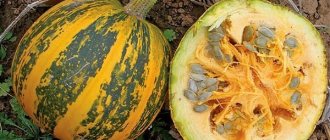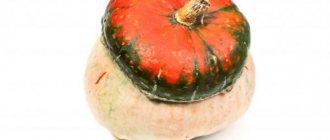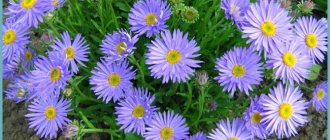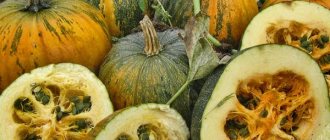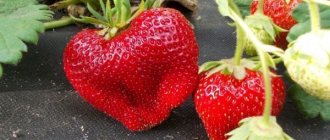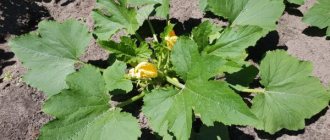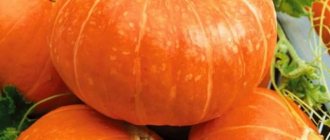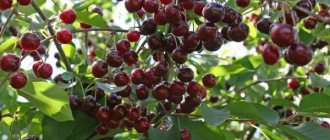Vegetable growing » Pumpkin
0
732
Article rating
Kira Stoletova
The pumpkin family includes a wide variety of varieties that differ in the size and color of the fruit, taste and ripening time.
Popular varieties of green pumpkin
Green pumpkin is one of the unusual varieties that is preferred to be planted as an ornamental variety. Some of its types are not inferior in taste to classic pumpkin.
Green pumpkin - the most popular varieties with descriptions
There are many types of pumpkins in the world, differing in color, color, shape, size, taste, ripening period and purpose.
There are dietary and gourmet varieties, fodder and even decorative varieties that decorate the garden or vegetable garden with herbs and fruits. In the multiple list, there was also a place for the green variety, which, as it turned out, is very beneficial for the body, tasty and in no way inferior in attractiveness to its relatives. Pumpkin belongs to the Cucurbitaceae family and is a herbaceous creeping plant with a powerful root system. The leaves are pentagonal, large, juicy green in color, with fine hairs and thorns all over the surface and on the shoots. The length of the vines reaches 5–8 meters and spreads beautifully along the ground, with the help of tendrils it clings to fences, trellises, tree branches, entwining everything around.
The fruits, depending on the variety, are small - the size of a pear, and large - up to 10-15 kg. The surface is dense, green, smooth, rough or with pimples. The pulp is yellow or orange, fleshy and very healthy, with a high content of vitamins and microelements. In addition, it is recommended to eat seeds; they contain a lot of manganese, magnesium, phosphorus, zinc and other minerals.
In gardening stores you can find different varieties of orange, yellow and white pumpkins, and there is also a large selection of green ones. It is difficult for a beginner to understand the proposed options, which ones are better, tastier, when they ripen and what they are intended for, so we offer a rating of the most popular green varieties.
All plants are grown in open ground and do not require special care. The quality of seed germination is high.
Pumpkins are divided into groups: hard-bark, large-fruited, decorative, early-, mid- and late-ripening, delicacy, vitamin, dietary and others. When choosing a variety, you need to take these factors into account and rely on the purpose of the vegetable. To decorate the garden, you should look for small-fruited, decorative species, for food use - large ones, with fleshy pulp and a sweet taste, and forage varieties are suitable for animals. The list offers the best varieties of all directions.
Marbled pumpkin has gained the greatest popularity in cooking because it has excellent taste, juicy, sweet flesh and considerable size. The variety is late-ripening; it will take at least 120-130 days to ripen, but the wait is worth it. The fruits grow up to 6-8 kg and have a gray-green color with streaks, streaks or splashes of light colors, which is how the variety got its name.
When cut, the pumpkin is bright orange in color, very fleshy, dense and sweet in taste, the amount of sugar reaches 13%. The thickness of the pulp is quite large, the seed nest is small, there are practically no voids. The skin is soft, which makes it easier to remove during cooking. The variety has proven itself well and has a lot of positive reviews.
The group of nutmeg pumpkins includes various varieties, but the Muscat Vitaminnaya hybrid turned out to be the sweetest and most beneficial. The composition contains a large amount of sugar and carotene, which makes it a leader in this area. The vegetable ripens late and reaches 7-8 kg; cultivation will require 140 sunny and warm days. The shape is round, flattened, with pronounced ribs, the color of the peel is dark green, monochromatic.
Vitamin nutmeg is stored for a long time, retaining all useful substances and is highly valued in cooking. A variety of dishes are prepared from it, pie fillings, casseroles, porridges, consumed boiled, baked and raw with apples, raisins, honey and other products.
Another popular variety of butternut squash is Mirani di Chioggia. The vegetable has a terrifying appearance with a pimply and not very attractive surface, but the flesh is sweet, tasty, and saturated with sunshine.
The crop is intended for cultivation in the southern regions, where dry summers prevail. The vegetable contains the maximum amount of sugars, ideal for diabetics and lovers of sweet dishes. The red-orange pulp is used to make jams, juices, cereals, puddings, casseroles, desserts and much more.
“Winter” pumpkin ripens 130 days after planting and is small in size - up to 4-5 kg. The skin is gray-green, dense, smooth to the touch. The variety is resistant to fungi and diseases, which allows fruits to be stored for up to 2 years in dry and cool places.
If the previous variety is suitable for the south, then “Vesnushka” is ideal for Siberia and the Urals. Its characteristics are as follows: weight up to three kg, round, slightly flattened shape; the main shade is light green with creamy strokes and splashes; The pulp is juicy, tender, sweetish, with a specific pear flavor.
Freckles can be stored for a long time at home and produce a bountiful harvest with frequent watering and organic fertilizing. It is demanding of moisture and soil fertility and is susceptible to powdery mildew. It tolerates sudden temperature changes calmly.
In addition to the varieties listed, there are also these no less tasty and healthy hybrids:
- Acorn.
- Altair.
- Miranda.
- Barn.
- Magic carriage.
- Arina.
- Winter Sampson many others.
Large-fruited and hard-barked ones are usually used as animal feed and are rarely eaten. The peculiarity of these varieties is their flat leaves and unusual shapes, often found:
Muscadines are usually pear-shaped with a low content of seeds and voids.
An unattractive pumpkin weighing 10 kg is a must-have vegetable on the autumn table. The multivitamin composition, tasty red-orange pulp and a lot of positive qualities make the Frog Princess indispensable in the dietary and medicinal menu.
The medium-late, large-fruited variety has a thick, lumpy, dark green skin, ripens on the 130th day and is well transported. It is not difficult to grow, but loves sunny areas. The vegetable looks like the skin of a frog, which “scares off” gardeners, but in vain. Its pulp is used in preparing dishes, preserves, juices and purees.
Pumpkins, a pronounced green color with an elongated shape, appeared on domestic beds not so long ago, but aroused unprecedented interest and demand. The variety is characterized by a rather hard fruit shell, smooth to the touch with an unusual waxy coating. The bushes are powerful, climbing with thick stems. Vegetables grow up to 10-15 kg in 130 days and reach a length of 50 cm.
The pulp is dense, pale, almost milky in color, the taste is sweetish. It is rarely used for cooking, but it is possible to cook a green vegetable that is fully ripened. If we compare nutmeg and wax pumpkin in terms of sugar content, the first is clearly the leader, but the second can be stored for up to 2-3 years without much effort and specific conditions.
The variety's homeland is Peru and its tropical jungles. Under natural conditions, figleaf pumpkin grows for several years and is considered a perennial crop. The shape of the fruit is similar to an oval watermelon, the color is dark green with cream spots. The taste and aroma are sweet, pumpkin. The pulp is coarse, light, with a yellowish tint; in cooking it is used as side dishes, in sweet and confectionery dishes, baked in pieces, and also used as a raw material for alcoholic beverages. The seeds are hard, black, and resemble watermelon.
The plant is powerful and grows strongly, entwining everything nearby, the length of the lashes reaches 10 meters. The fruits are widely used in food production, and the leaves and seeds are used in folk medicine; ointments, tinctures are made from them, and applied to sore spots.
Not only green varieties of pumpkins are tasty and healthy, but also orange, white, and gray ones. The best orange ones include: Melon, Rossiyanka, Kapitoshka and others. The vitamin composition and high content of carotene and natural sugars puts the vegetable in first place in the list of dietary products for diabetics, those losing weight, and people with problems with the liver, gall bladder, and poor eyesight.
Popular varieties and features of their cultivation
They contain zinc, which prevents prostate disease, the pathological process of tissue proliferation. A popular folk remedy that enhances and treats male power is a mixture of ground pumpkin seeds and honey. Balls from this mixture are placed in a cold place and taken half an hour before meals, 3-4 pieces.
Pumpkin seeds are no less beneficial for women than for men; with their help, they get rid of polyps in the genital and digestive organs. For treatment, prepare a mixture of 1 egg, 1 tsp. spoons of ground grains and 1 tbsp. spoons of sunflower oil, steamed for 1/3 hour and stored in the refrigerator.
Now you know, dear readers, that pumpkin seeds, the benefits and harms of which have been well studied, can have a positive effect on your body - but if used correctly, then there will be no harm!
Pumpkin began to be grown in America before our era. In Ancient Egypt, this plant was a delicacy. The ancient Romans learned how to make durable vessels from pumpkins. In China, such dishes were placed only on the table of the imperial family.
Nowadays, it is a healthy and beloved product by many, which has become firmly established in the diet of a modern person who cares about their health.
To date, three of them have gained particular popularity.
It is distinguished by a ribbed stalk, on which grooves are clearly visible. It came to us from Mexico, and three of its types are known: long-climbing (produces small but numerous fruits), bush (zucchini and squash), and decorative.
It has a pentagonal stalk, which widens towards the base. The surface is ribbed or smooth, the shape is elongated, at first the fruits are colored green, but as they ripen they become yellow or brown. The seed chamber is small and the pulp layer is thick.
This species has a rounded cylindrical stalk. The fruits are flat with a bumpy surface and very sweet in taste. In this culture, three varieties are distinguished: gray-fruited, winter and mammoth.
There are a great many varieties of this popular all over the world and very useful plant. Some of them are grown for animal feed, others are famous for their sweetness and juiciness, for which chefs love them, and others are rich in valuable seeds. In recent years, decorative varieties of pumpkins have also become popular. In all these varieties, green pumpkin is found (you can see the photo in this article).
What does a green pumpkin look like? What varieties are there? We will answer these questions below and look in detail at the most famous green pumpkin varieties with photos and descriptions.
One of the most “old” varieties grown in Russia. They are mainly planted in the Urals and Siberia, since the crop has strong immunity to sudden weather changes. It is recommended to grow in seedlings, as this makes it easier for the plant to adapt to external factors. The pumpkin is oblong, average weight is about 5 kg.
Gribovsky is a mid-early variety, the first harvest is obtained 80-90 days after planting. The bush is formed into 1 or 2 stems, the beds are regularly watered and loosened. Pumpkin responds well to organic fertilizers in the form of liquid mullein or nettle infusion. As befits varieties for the Urals and Siberia, Gribovskaya bush 189 rarely gets sick and is not attacked by insect pests. The yield is average, about 10-20 kg per bush.
Freckle
An interesting ultra-early variety. As a rule, Freckle is sown with seeds in open ground. An open, bright and warm place in the garden is suitable for growing. It is best to plant Freckles after potatoes or legumes, but in no case after zucchini or cucumbers. Before planting, be sure to germinate and harden the seed material. Also use growth stimulants, they will speed up seed germination.
About 8-10 “freckles” appear on one bush. The weight of one is about 1 kg, on average about 9 kg is removed from a bush. The pumpkin is green with yellow splashes, hence the name. Young vegetables are excellent for processing, including stuffing.
Miranda
Refers to mid-season varieties. Vegetables are round and compact. The color is rich, emerald green, with light inclusions. The weight of one pumpkin is about 3 kg. They are grown both in open ground and in greenhouses. About 7-10 vegetables ripen on one bush. Miranda has a high nutrient content and is excellent for children's and dietary nutrition. In addition, gardeners value the crop for its ease of care.
We suggest you read How to cook eggplants? Basic tricks and nuances || Do you need to peel the inside of eggplants?
For cultivation, it is recommended to install a drip irrigation system. It ensures the flow of water under the root, bypassing the stems and leaves. As a preventive measure, the bushes are sprayed with a soap solution, it prevents the occurrence of fungal infections. Also, do not forget to sprinkle the lashes with soil. If this is not done, they will break the leaves, which will have a bad effect on the health of the plant.
Gymnosperm 14
The variety was bred more than 60 years ago. The pumpkin is oblong, slightly rounded. The weight of one is about 6 kg, the yield per bush is about 30 kg. The pulp is tender and sweet. Gymnosperm 14 is easy to grow and does not require special skills. The bushes are compact, the leaves are dark green. The root system is powerful, as are the lashes.
In addition to the pulp, the seeds of Gymnosperm are also used in cooking. For example, they make delicious muffins with cherries and pumpkin seeds. In addition to taste, baking will enrich the body with essential vitamins, improve digestion and well-being.
Vitamin
The variety belongs to the Muscat family and is distinguished by its excellent taste and sweetness. Muscat varieties are often compared to melon. Ripening time is late, about 130 days. It can be elongated or round in shape, with slight ribbing. It is better to grow vitamin pumpkin in seedlings. Seedlings are prepared 20-30 days before planting in the ground. The optimal distance between the bushes is at least 1 m. To prevent the seedlings from freezing, they are covered with film for the first time.
https://www.youtube.com/watch?v=s0Qy9JnzWvM
Don’t forget to loosen the soil, this saturates it with oxygen and makes it airy. Also regularly remove weeds and cover the vines with soil. During the fruiting period, pay special attention to nitrogen-containing fertilizers, for example, use urea or ammonium nitrate. The weight of one Vitamin pumpkin is about 7 kg. One bush gives about 6-7 vegetables.
One of the best mid-season varieties. Does not require special fertilizers and is immune to common diseases. Excellent for growing in regions with difficult weather conditions. The weight of one striped pumpkin is about 5 kg. The vegetables are aromatic and are widely used in cooking. The barn is stored for a long time and does not lose its taste and aesthetic qualities. For example, a vegetable can be stored in the basement for about 1 year.
From 1 sq. m harvest about 40 kg. Pumpkins ripen gradually, the yield is friendly. Pumpkin is great for processing and is even used to make jam and sweet jelly. People suffering from diabetes mellitus especially appreciate the dish. It is known that pumpkin is an excellent substitute for sweets and desserts. Will complement your table in winter and autumn.
Azure
The color palette of the Azure Pumpkin ranges from dark green to gray. The surface is ribbed, the shape is round. It ripens within 110 days, so the variety can be called medium-late. But the flesh of the Azure vegetable is bright orange, crispy and tasty. Pumpkins are large and round, weighing about 6 kg. Pumpkin is often added to milk porridges and made into puree soup.
Azure loves sandy loamy fertile lands. Its roots are powerful, so do not forget about timely watering. Add Kornevin or Mortar as fertilizer. They increase yields, improve crop health and protect against pests.
Use medications in accordance with dosages and recommendations. Otherwise, they will not benefit the plants, but will only harm them. You can purchase such products at any gardening store.
Medical
A powerful plant with short vines. Refers to early ripening and productive. From 1 sq. m harvest about 5 kg. Harvested pumpkins are perfectly stored and transported. The variety is resistant to pests and diseases. However, for preventive purposes, it would not be a bad idea to periodically spray the bushes with a solution of wood ash from a spray bottle. This is especially true in dry and hot summers.
Pumpkin pulp is recommended for those who have stomach diseases, especially raw or boiled. The vegetable does not cause bloating or gas, so you should eat at least one piece of Medicinal Pumpkin per day. Pumpkin is 90% water and contains a huge amount of beta-carotene. The variety is suitable for those who want to lose excess weight.
In the distant past, Indians used pumpkin not only as a food product, but also as a material for making household items. Long ribbons were made from the pulp and rugs were woven, which were later laid in houses. Pumpkin design was common among the peoples of South America, but in the Old World the pumpkin is known from a completely different side.
Green pumpkin: properties, varieties
The article presents green pumpkin: benefits, properties, description of popular varieties, growing rules.
Pumpkin contains a lot of useful microelements and vitamins that people need so much, and buying it every time at the market is quite expensive, so we suggest you grow it on your own plot, and besides, it’s not at all difficult. This culture is unpretentious in care, and the taste is excellent. Usually it gives a bountiful harvest, so you can always please yourself with delicious pieces of crispy pumpkin. It is used to prepare porridges, soups, make jams, use it in baking, and the juice obtained from ripe pumpkin is wonderful. I hope we have convinced you to plant this vegetable crop on your plot. However, it is very easy to get lost in the variety of varieties, therefore, before choosing one or another variety, you need to carefully study its characteristics and description. Today we will tell you about green pumpkin, so carefully study the article and get acquainted with this record holder for the content of microelements and nutrients among many fruits and vegetables.
How to choose a pumpkin
To select a ripe and healthy vegetable, use the following tips:
- Don't buy a pumpkin that has dents or cracks. This means that the vegetable has already begun to deteriorate.
- The larger the pumpkin, the more water it contains.
- A quality product has dry seeds and deep orange flesh.
- The stalk should be dry and the rind should be hard.
If you buy a vegetable from a neighbor, ask what variety it is and make sure the pumpkin has been stored correctly. The ideal place is a dark and dry room, such as a garage or cellar. Carefully inspect the product and tap it. If the sound is dull, it means the pumpkin is ripe and ready to eat.
Green pumpkin: basic information about properties
Photo of green pumpkin
During the cold season, we all need vitamins and microelements, so we very often go to the pharmacy for the necessary medications, but many useful substances can be safely obtained by eating pumpkin. It contains a lot of carotene, vitamins and microelements. Green pumpkin seeds are useful for the functioning of the digestive tract, strengthening the immune system; they are also used by hypertensive patients to prepare medical nutrition dishes. Round green pumpkin is a very low-calorie product, so green pumpkin can be used as a vegetable for your diet and you don’t have to worry about your figure.
Of course, pumpkin is familiar to every person since childhood, but do not forget about this vegetable in adulthood; pumpkin is very accessible, easy to grow, and also very healthy and popular. Gardeners often grow it in their garden plots, and some craftsmen plant it directly on the balcony. Of course, it’s much easier to grow in the country, so it’s best to save a piece of free land for it. You should not plant pumpkin next to zucchini, squash and cucumbers, as these plants are cross-pollinated, which means their fruits will not be what you expect.
Pumpkin usually has large fruits and strong roots, so it grows well in different climates. The stems of this vegetable are climbing, so they quickly fill the free surrounding space. It is recommended to plant green pumpkin seeds at a large distance from each other. It should be noted that pumpkin has quite thorny leaves and vines, so you should wear gloves when working with this plant. The pumpkin climbs beautifully both on the ground and over various fences. Therefore, it is often planted near agricultural buildings, clinging to the protrusions with its tendrils; the pumpkin also grows vertically. With the help of this plant you can create a green gazebo in which you will hide from the scorching sun and enjoy a wonderful aroma.
If we talk about fruits, it should be noted that usually the pumpkins of this vegetable crop are both very small and quite large. Their weight can reach 12-15 kilograms. Pumpkins are shaped like round, oval, flattened, and pumpkins are usually divided into segments. Therefore, the outer surface of this vegetable is ribbed. Pumpkins come in yellow, orange, gray and green colors. If we talk about the peel, it is quite dense, smooth or rough. The pulp is elastic, with a characteristic odor.
Pumpkin seeds, benefits
Many gardeners grow pumpkin, but not everyone knows that it is considered one of the most useful plants. The benefits of fruits, seeds, flowers and leaves are great for humans. The pulp is used to prepare delicious dishes, but the seeds are used to treat and prevent various diseases.
A person who uses traditional medicine and one who prefers traditional medicine should know that pumpkin seeds can be treated. Pumpkin seeds have a pronounced therapeutic effect, which makes it possible to use them to get rid of many diseases.
Healthy pumpkin seeds, the composition of which is quite rich, are good for treating the digestive tract, sexual problems, and for fighting roundworms and other human parasites.
The set of elements that give the treat such a strong effect is large, consisting of chemicals (calcium, fluorine, sodium, potassium, selenium, copper, zinc, magnesium), vitamins (K, C, E, A, B), nutrients (proteins , carbohydrates, fats), water, fiber and ash. Such rich content forces us to pay special attention to solving the problem, pumpkin seeds, benefits and harm.
| Manganese | 74% |
| Phosphorus | 57% |
| Magnesium | 48% |
| Copper | 48% |
| Zinc | 23% |
| Protein | 20% |
| Iron | 16% |
Regarding the calorie content of pumpkin seeds, it is very high; eating one hundred grams of seeds will give a person more than 500 kcal, which, of course, will upset those whose figure is under constant observation.
calorie content of pumpkin seeds 559 kcal
- digestive - liberation from parasites, stimulation of the excretion and movement of bile, regulation of the process of food digestion, cleansing organs of lead and cadmium;
- establishing metabolic processes if the body is weakened and exhausted - helping to increase weight, reducing sugar levels;
- circulatory – cleansing blood vessels from bad cholesterol, improving the functioning of the brain, head and blood system. Strengthening the walls of large vessels, reducing lower pressure, reducing pain in the heart occurs thanks to folic and linoleic acids found in the seeds. Increasing hemoglobin in the blood - with the help of iron, ensuring stable activity of the heart muscle - under the influence of magnesium and potassium, stimulating brain function - with phosphorus and zinc. And, as a result of consuming seeds, improved memory, reduced fatigue and chronic inflammation;
- nervous - restoration of its work, action against neuroses and depression;
- excretory - has a diuretic property, a preventive effect against sand and stones;
- sexual - treatment of prostatitis;
- musculoskeletal - establishing replenishment of bone tissue, stopping osteoporosis;
- treatment of cancer tumors.
- Pumpkin seeds became the basis for the development of the drug Pumpkin, if the liver, digestive organs are sick, there is a burn, herpes, eczema and many other problems, then this drug will be very useful.
We suggest you familiarize yourself with the Temperature for flowers on the balcony
Pumpkin seeds, the benefits and harms of which have not been fully discussed, have contraindications when consumed, so let’s fill this gap and consider this point in more detail.
The elements that make up pumpkin seeds can bring not only benefits, but also harm. Before deciding on their use, you should consult a doctor for advice.
Pumpkin seed poisoning can occur if you eat them fried and salted, especially in large quantities; the increased acidity level is an obstacle to eating excessive amounts of this product.
The daily intake of pumpkin seeds should be reduced if there is obstructed intestinal patency. When losing weight, you need to stop eating seeds. Cleaning the seeds must be done by hand, otherwise the enamel of the tooth will be damaged and tartar may appear.
Green pumpkin: practicality and benefits
Green pumpkin: practicality and benefits
Can you eat green pumpkin? Despite such species diversity, any pumpkin is very useful. Therefore, feel free to plant it on your site. It contains fiber, vitamins and microelements. The fruits contain a lot of phosphorus, iron, zinc, and manganese. Literally everything in a pumpkin is healthy: from seeds to pulp. Therefore, people have been using it for quite a long time to treat cardiovascular diseases, maintain the functioning of the nervous system, and the digestive tract. It should be noted that this product does not contain allergens, so it is often recommended to give pumpkin to children. Green pumpkin can also be used for vegetarian nutrition. Therefore, pumpkins are loved not only because of their ease of growing, but also because of their wonderful, tasty, dietary and healthy fruits. In order to grow a pumpkin, you do not need to have a lot of experience; it is enough to choose the right seed material, prepare the site and provide the minimum favorable conditions for the development and fruiting of this crop.
What are the benefits of pumpkin?
Every autumn we are blessed with a new harvest: various varieties appear in stores at low prices, and cafes and restaurants create special seasonal pumpkin-based menus. In addition to taste, the product is incredibly beneficial for the health of adults and children.
The following elements are of particular value in the vegetable:
- B vitamins strengthen the immune system and reduce irritability.
- Vitamin K is extremely rare in food; its value lies in the fact that it improves hematopoiesis and is involved in the synthesis of bone tissue.
- Vitamin D improves metabolism and has a healing effect on the gastrointestinal tract.
- Vitamin T helps the body better absorb nutrients and speed up digestion, preventing obesity. Like vitamin K, it is extremely rare in foods.
- Folic and ascorbic acids are beneficial for the cardiovascular system.
- Potassium and magnesium prevent diabetes and have anti-inflammatory properties.
- Pectin removes cholesterol from the body and cleans blood vessels.
Green pumpkin is actively used in the preparation of dietary dishes. It relieves swelling, improves stomach function, and improves mood. Pumpkin is superior in iron content even to apples, so its consumption also has a positive effect on brain function.
In addition, pumpkin is used as a diuretic, since it contains substances that stimulate kidney function. To retain more benefits, consume the product raw or baked.
For men, pumpkin is useful because it contains vitamins C, B1, B3, B6, L-carnitine, zinc and other “male” minerals. They improve the absorption of fatty acids, increase endurance, and have an effect on the reproductive system. For the fair half of humanity, pumpkin contains vitamins A and E. They prevent aging, moisturize the skin, strengthen hair and nails. Pumpkin extracts are used to make many cosmetic products.
To ensure that the body receives useful substances, the seeds must be properly prepared. Temperatures above 45 °C are not allowed; the beneficial chemical composition of fried seeds will be disrupted.
roasted pumpkin seeds
Pumpkin seeds are widely used in folk medicine. Many people know the antihelminthic method of pumpkin seeds. The component cucurbatin is lethal to parasites, but absolutely harmless to the human body.
How to get rid of roundworms using pumpkin seeds, quickly and without chemicals? To do this, mix 0.3 kg of seeds (meal) ground together with the skin and 0.1 kg of honey. The mixture is eaten within 60 minutes before meals. After 5 hours, drink a laxative or about two liters of salted water, or give an enema.
Such a popular and quick way to get rid of worms is accompanied by a rise in temperature, redness of the throat, headache, snot, so it is better to get rid of them gradually - take this mixture for 2 months in the morning and before bed, adults can take 1 teaspoon, teenagers - 1 /2 tsp, preschoolers - 1/4 - 1/3 tsp.
What are the benefits of pumpkin seeds for men?
The pulp of the fruit is not only tasty, but also very healthy; pumpkin is a storehouse of vitamins and valuable minerals. It contains pectins, proteins, fiber, carotene, acids, sugars. The seeds contain a large amount of essential oils and zinc. Pumpkin is a low-calorie product, which is why it is included in many diets.
Green pumpkin varieties
Green pumpkin can be planted both for food and for decoration. If you like to arrange contrasts, then you will definitely like this variety of decorative pumpkin. Currently, there are many varieties of this plant that are used not only for food. Therefore, this favorite can also boast of special beauty, because many gardeners plant these ornamental plants even in flower beds. It is best to plant the pumpkin near some supports so that its stems can grow vertically. Very often, these plants are used to decorate gazebos and hedges, and some craftsmen even decorate balconies. In addition, when decorating a plot with pumpkin, in addition to the beautiful exotic decorative look, you will get an incredible aroma. When flowering, this crop fills the surrounding space with incredible sweetness, and the fruit ovaries can decorate any flowerbed.
Popular varieties of green pumpkin
The pumpkin family includes a wide variety of varieties that differ in the size and color of the fruit, taste and ripening time.
Popular varieties of green pumpkin
Green pumpkin is one of the unusual varieties that is preferred to be planted as an ornamental variety. Some of its types are not inferior in taste to classic pumpkin.
Pumpkin: description
It is an annual plant with a powerful, well-developed root system and creeping herbaceous stem. It is spiny, pentagonal, and forms tendrils in the axils of the leaves, with the help of which the plant clings to supports and stretches upward. The stem can be up to eight meters long.
The five-lobed large leaves also cover small hairs. Pumpkin blooms with orange or yellow large single flowers, which attract the attention of pollinating insects from afar. They are male, unisexual, and have a long peduncle. Flowering begins at the end of June and continues until the beginning of July.
We suggest you familiarize yourself with Oil for lubricating chainsaw chains
In autumn, thick-skinned fruits ripen. Their shape, size and color depend on the variety grown. Inside, under the thick skin, there is an oily, juicy pulp with many white large seeds.
Flasks, jugs, bottles, and cups are made from tableware gourd (lagenaria). It is believed that such dishes have good energy.
Description of green varieties
Green pumpkin is a herbaceous plant. This species often grows along fences and fences, it clings to them by means of antennae.
It usually has large, dark green, pentagonal leaves. There are small thorns on the surface of the foliage and shoots. The length of the lashes creeping along the ground is up to 5-8 m.
Decorative fruits are small, the size of a pear or apple, but in some varieties the weight reaches 10-15 kg.
A characteristic feature is the color of the fruit - it is a contrasting green, but the surface of the pumpkin can be different - smooth or rough. The pulp is a classic yellow-orange color.
butternut squash
Butternut squash is characterized by its characteristic taste and high content of vitamins. A late-ripening species that does not tolerate temperature changes.
The best varieties of nutmeg pumpkin: Vita, Guitar, Butternut, Vitaminny, Prikubansky, Zhemchuzhina.
Variety Butternad
The juicy and sweet butternut pumpkin reaches small sizes. The pulp of this pumpkin is aromatic, sweet, and not very fibrous. Butternut's rind is smooth and yellow-brown.
The photo shows Butternut pumpkin fruits
Prikubanskaya
The variety is mid-season - 3 months - 136 days - pass before harvesting. The weight of the “Kuban” pumpkin is 2.2 – 5 kg. The bark of the Prikubanskaya pumpkin variety is thin, the flesh is red-orange in color. Juicy and tender. Kuban pumpkin is valued for its evenness of fruit, taste, and good yield. Stored for 3 months.
Photo of Prikubansky pumpkin variety
Spanish guitar
Spanish guitar is a mid-season nutmeg pumpkin variety. Its taste is unique, a bit reminiscent of apricots. There are few seeds in pumpkins. Store until the end of spring.
In the photo, the muscat variety of pumpkin Guitar
Pearl
Another representative of high-yielding muscat pumpkin varieties is Zhemchuzhina. It is similar in appearance to the Butternad variety - the fruits are also elongated and cylindrical in shape. The color of pumpkins is yellow-orange. The thick and tender flesh of this butternut squash is orange in color. The weight of pumpkins reaches 8 kg. Transportable and lightweight.
| Read the article about bitter gourd |
Hard-barked species
Hard-bark pumpkin is not capable of providing gastronomic qualities at the proper level, because it is not distinguished by its sweetness.
It is often grown as fodder for feeding livestock.
The shelf life is significantly shorter compared to other types. However, it has a number of advantages:
- fast ripening times, allowing harvests to be obtained by the end of summer - the very beginning of autumn;
- some species are gymnosperms;
- the seeds differ in their taste.
There are several popular varieties.
Gribovskaya-189
The pumpkin is early ripening and produces a harvest 85-95 days after planting in open ground. The appearance is similar to a zucchini.
The pumpkin bush is compact, the vines are short. Vegetables grow elongated, the average weight is 2.5-5 kg.
The color of the peel is dark green, but when stored in a warm room they change color to yellow. Pumpkin pulp is a classic yellow color, without any special taste.
Freckle
Freckle is one of the bush pumpkin species that ripen in a short period of time and produces the first harvest 90-100 days after planting. The shape of vegetables is round and flattened.
The variety will delight you with an early harvest
Average weight – 0.8-2 kg. The color of the bark is light green with pale yellow specks - freckles. Where the variety got its name from. The pulp has a pear-like aftertaste.
Gardeners prefer to plant freckles in regions with an unfavorable climate and frequent temperature changes, because This pumpkin is resistant to low temperatures.
Miranda
Miranda is a hard-barked species with an average ripening period; it produces a harvest 100-110 days after planting in the ground. Semi-bushy variety with medium-length vines.
The surface of the vegetables is covered with gray-light green spots. The shape of the fruit is round. Average weight – up to 4 kg. Gymnosperm, seeds without shell in large quantities.
Acorn
The hard-barked Acorn species is early ripening. Technical ripeness occurs 85-90 days after planting.
Hard-barked pumpkin varieties:
“Acorn” - or acorn, in common parlance. You probably already guessed that the fruits of this variety look very similar to acorns. The color of the pulp is orange with a yellowish tint, and the taste is sweet. The peel has different color shades.
“Aport”
The shape of the vegetable is almost round; according to the ripening period, it belongs to the mid-season varieties of pumpkin. The peel color is orange, the fruits are quite large, up to seven kilograms. The pulp is distinguished by its delicate, sweet taste, the color of the pulp is orange with a yellow tint.
Pumpkin “smile”
A representative of early ripening varieties, the ripening period is slightly less than 3 months. You can collect up to 10 fruits from a bush, but they themselves are small, weighing about one and a half kilograms, the peel is light orange, divided by light stripes. It is well preserved and can be stored right up to January at room temperature. Sweet pulp with an unsurpassed aroma will definitely delight lovers of this vegetable.
Spaghetti pumpkin
The name speaks for itself. You probably already guessed that the pulp of this variety will be fibrous and reminiscent of the famous Italian dish. The color and shape are very similar to the color and shape of a melon. The maturity of the fruit can be determined this way, because when they turn yellow, then they are already fully ripe.
"Freckle"
Belongs to early ripening varieties. The vegetable itself is not large, and rarely exceeds a weight of three kilograms. The skin is light green. The flesh is orange with a yellow tint, the taste is sweet, somewhat reminiscent of a pear. Refers to high-yielding varieties with good keeping quality.
“Gribovskaya bush 189”
Representative of varieties with early ripening, approximately 100 days, from planting to harvest. The shape of the fruit is oval, long, the color of the peel is light orange. The fruits themselves are not large, their weight does not exceed four kilograms. The pulp is orange and very tasty.
Pumpkin “dacha”
Refers to varieties of medium ripening. The fruit is oval-shaped, orange in color with green spots, weighing a little more than four kilograms. The pulp is orange, bright, has a juicy structure, sweet taste and vanilla aroma. The yield of “dacha” is quite high, and the shelf life of the fruit is up to four months.
Orange bush pumpkin
Belongs to representatives of early ripening varieties. The fruits are quite large, up to five kilograms, round in shape, orange in color. The pulp is fleshy, up to seven centimeters, the taste is very high. It is characterized by good keeping quality and ease of cultivation and care.
Muscat species
Nutmeg varietal varieties are characterized by high taste qualities, having a nutty aftertaste.
Vitamin
Among the green bush varieties is Muscat Vitaminnaya pumpkin. It is classified as late-ripening, fully ripening in 140 days. Heat-loving, requires a sufficient amount of sunlight. The harvest can be stored for a long time.
It has a high content of sugar and carotene, so it is mainly used for preparing first and second courses, cereals and desserts.
The fruits are round, slightly flattened, ribbed. Average weight – 7-8 kg. The peel is dark green.
Mirani di Chioggia
The nutmeg variety Mirani di Chioggia produces large fruits weighing up to 7 kg. However, the vegetables have an unattractive appearance - the ribbed, pimply, dark green rind makes them look like uneven balls.
In this form there are practically no voids, the structure of the pulp is fleshy. The variety is late-ripening, ripening in 4-4.5 months, but compensates for this disadvantage with an increased shelf life.
Augustine
Fruits can be stored fresh for a long time
Mid-season Augustine nutmeg pumpkin produces the first vegetables in 105-110 days. The long-climbing plant has elongated fruits with expansion on one side in the area of the flower scar. The surface of the bark is smooth, dark green in color, with a faint white-gray waxy coating.
The average weight of vegetables is 4-6 kg. It has a short shelf life, providing taste and presentation only for 3 months.
Family
Butternut squash requires 130-135 days to ripen. The fruits are elongated, long, dark green in color with a faint gray-light green waxy coating. Average weight 8-16 kg.
It is resistant to low temperatures and at the same time withstands short-term drought well. Shelf life – 2 months.
The pumpkin is green, like a zucchini. The best varieties of nutmeg, hard-skinned and large-fruited pumpkins
Updated
In the article you will learn about the best varieties of pumpkin with photos and descriptions that are suitable for growing in different regions. If you prefer to cook stewed or fried dishes from vegetables in the summer, then purchase seeds of hard-barked summer varieties. For collecting juice and for long-term storage until spring - nutmeg or large-fruited varieties, and for fresh consumption - gray-fruited varieties, which are famous for their sweet pulp.
Hardbark pumpkin
The common name is Cucurbita pepo. These varieties get their name because of their very thick, woody skin. Their advantage is early maturation. The size of the fruit is not very large, but the seeds are the most delicious.
Gymnosemyanka
Suitable for growing in any region of Russia. The pumpkin grows oval with a dark green skin that is smooth to the touch. Can reach 6 kg. The inside is yellow, dense, unsweetened, crispy. Under favorable conditions, 500 centners are harvested per hectare.
Spaghetti
Early ripening pumpkin acquired its name because of the boiled pulp, reminiscent of the taste of pasta. The shape of the vegetable resembles a melon. The peel is pale yellow. Weight does not exceed a kilogram. The fruits are fragrant and juicy and can be stored for no more than 60 days.
Chit
Recommended for cultivation in the central part of Russia. Ripening takes approximately 120 days. The crumb is resistant to anthracnose, but can be affected by powdery mildew.
The stem of the plant is long and powerful. The weight of the round fruits, slightly flattened at the bottom and top, is up to 4 kg. With insufficient watering, the size decreases significantly. The light gray rind is dense, and the orange-yellow flesh is not very juicy, soft with a rich, bright honey flavor. The purpose is universal.
The crumb is stored for more than six months, improving its taste every day. Seeds are harvested for a new harvest.
Adagio
Refers to mid-season. Ripens well in northern regions. The average weight of a turban-shaped pumpkin is 2.5 kilograms. Contains carotene in higher concentrations than carrots.
Almond
An early variety weighing 5 kg has a delicate almond aroma. The shape is rounded and flattened. Sweet and dense inside.
Advantages:
- good keeping quality;
- resistance to cold;
- excellent presentation;
- long-term storage.
Flaws:
- requires regular watering;
- grows well only in fertile soil;
- susceptible to powdery mildew.
Used for culinary purposes and feeding livestock.
Gribovskaya bush
The plant grows powerful and bushy. Belongs to early ripening, high-yielding. Technical maturity occurs 90 days after the first shoots. The shape can be cylindrical or oval. The surface has a small number of ridges and is smooth. Maximum weight 6 kg. It has good keeping quality and transportability.
“Gribovskaya Bush” is suitable for making juices, porridge, and purees.
Advice! To protect against weeds, mulch the soil. Use pine needles, peat and dry soil.
butternut squash
The second name is Cucurbita moschata. It has high taste, long shelf life, but is the most difficult to care for. Not recommended for growing in the northern region. Refers to late-ripening, heat-loving. It doesn't have time to ripen in the short summer.
In the middle zone they are grown only by seedlings. To do this, the seeds are sown in the last ten days of April. In early June they are transplanted into open ground.
Pumpkins of this variety can be eaten raw and picked slightly unripe, as they ripen well at home.
Spanish guitar
It got its name for its unusual, beautiful shape. The length depends on the fertility of the soil, it can be from 70 centimeters to a meter, the weight does not exceed 8 kg. It belongs to the mid-season variety and is famous for its excellent keeping quality. The taste is vaguely reminiscent of apricot. Seeds in small quantities are found only in the thickened part. The skin is thin without ribs. Suitable for raw consumption.
Large-fruited species
Gardeners love large-fruited varieties because these species have practically no disadvantages. They produce good yields, vegetables grow in large sizes (from 7-8 kg or more) and perfectly retain their external qualities and beneficial properties for a long time during storage.
Zorka
The large-fruited Zorka matures in 105-115 days and is a mid-season climbing plant. Vegetables are round and flattened. Average weight 7.0 kg. The peel is gray-green, segmented, with yellow and pinkish spots.
Pumpkin pulp contains a high amount of carotene, is low-juicy, and sweet.
Zorka is a species resistant to powdery mildew and bacteriosis.
Farmer
The mid-season variety Khutoryanka gives the first harvest 120-130 days after planting. It is a climbing plant. Vegetables grow in an oblong cylindrical shape with a dark color. Average weight – 7-10 kg.
Gardeners value the plant for its resistance to low temperatures and good transportability.
Hubbard
The Hubbard varietal variety is large-fruited and at the same time nutmeg, produces large fruits weighing up to 10 kg 110-115 days from the moment of planting. Pumpkin pulp is dry and crumbly with a characteristic nutty aftertaste.
Signs of pumpkin ripeness
Regardless of the type and early maturity of the pumpkin, its fruits have general signs of ripening:
- First of all, the pumpkin stalk becomes hard, loses its juiciness and takes on the appearance of wood or cork.
- Pumpkin bark changes color in most varieties and varieties. Shades of green are replaced by yellow and orange tones, and the pattern becomes clearer.
- The bark thickens and is difficult to damage with a fingernail.
- The vines and foliage of the plant wither, turn yellow and die.
If pumpkins with characteristic signs of ripening are removed from the garden, the fruits are well stored, their pulp does not lose moisture and taste for a long time.
It is better to pre-ripen pumpkins that are not fully ripe until the fruit is completely protected from the external environment. But it is better not to store ovaries with unformed bark, but to immediately process them into juice, home-canned food or culinary dishes.
It is important to remember that not all varieties change color by autumn. A similar exception can be considered wax pumpkin, varieties with gray and white bark. The shade of butternut pumpkins changes slightly.
When a pumpkin is put away for storage, these signs can be considered a selection criterion and a guarantee that the fruits will not dry out or rot.
Sweet species
Sweet varieties contain a lot of carotene
Sweet varietal species grow small in size, but are distinguished by high gastronomic qualities, inherent sweet taste and high carotene content.
Sweet tooth
The early ripening species Slastena ripens in 85-95 days after planting. It is a climbing plant. Vegetables have a round shape. The bark is smooth, segmented, dark. The average fruit weight is up to 6 kg.
It is characterized by a high content of carotene and pectin in the sweet pulp, which ensures good taste.
Other advantages include an increased shelf life of up to 9 months while maintaining the original presentation. When grown, resistance to drought and elevated temperatures was noted.
Barn
Mid-season Granary produces the first harvests after 110-115 days from the moment of planting. A weakly climbing plant with round-shaped fruits, the bark of which is dark green in color and covered with black spots or white-striped.
The average fruit weight is 2-4 kg.
The main advantage of the variety is the increased content of carotene and the juiciness and sweetness of the pulp inherent in sweet types of pumpkin. It is well stored without losing its beneficial properties throughout the winter.
Azure
Mid-season Azure ripens in 100-125 days. The plant is long-climbing. Vegetables grow 4-5 kg each, the shape is flattened, the color of the bark is gray with greenish and brown. Pumpkin pulp is characterized by increased sweetness.
When should you harvest a pumpkin?
Pumpkin is harvested in dry weather, before frost, when the bulk of the fruits are fully ripened, usually in September, and in the south - when the leaves completely die off.
Only some very late-ripening varieties such as Stolovaya Zimnyaya have fruits that are harvested unripe (they ripen during storage). The maturity of fruits in large-fruited pumpkin varieties is determined by the dried and corked stalk, and in hard-bark and nutmeg pumpkins - by changes in the color and pattern of the fruit bark. When harvesting, it is necessary to preserve the stalk 3-4 cm long and prevent damage to the fruit. Pumpkins harvested in rainy weather need to be dried.
Decorative types
The main purpose of decorative greenfinches is to decorate the garden area.
These plants are part of landscape design and are used to decorate gazebos, fencing and fences.
The fruits are usually unusual in size and shape, and the bark is often covered with patterns of stripes, hatching and speckling. The harvest is harvested before it is fully ripe and dried to later be used as decorative elements.
Apple goose is the most popular variety. It is not used for food purposes.
Green pumpkin dessert recipe
The baked pieces resemble marmalade and have an original sweet and sour taste. If you drain the liquid and dry them in the oven, you will get delicious candied fruits.
- Cut the pumpkin pulp and peeled lemon into 2 x 2 cm cubes.
- Mix the prepared products with sugar and place them in a baking dish.
- Cover the pieces with a lid and place in the oven preheated to 170°C for 30 minutes. Stir the ingredients and return them to the oven for another 10 minutes.
Cool the treat at room temperature and then place it in the refrigerator for 2 hours. Serve the treat chilled with tea or coffee.
Is it possible to eat unripe pumpkin?
The dry matter content in pumpkin fruits is on average 6-8%, in the best varieties it reaches 15-20%, sugars on average 5-6%, and in some up to 10%. The amount of sugars varies dramatically depending on the pumpkin growing area. The amount of starch reaches 2-7%. Before ripening, it is most abundant in fruits, then the starch content decreases, and when stored it disappears completely. Pumpkin fruits also contain vitamin C, carotene, nitrogenous substances, organic acids, fiber, pectin substances, a number of ash elements, and the seeds contain up to 41-48% fat.
From the moment the fruit ripens, the dry matter content slowly decreases with an increase in the amount of sugars and pectins. The higher the percentage of starch in the pumpkin, the better it is stored and the more sugary it becomes during storage. The higher the carotene concentration, the more intense the color of the pulp.
The chemical composition of fruits changes significantly during storage, when some of the carbohydrates are consumed for respiration. In this regard, the amount of sucrose in fruits decreases. During long-term storage, a relative increase in pectin and fiber occurs in the pulp of pumpkin fruits due to a decrease in sugars and starch.
The consumption period is more extended than that of watermelons and melons. Pumpkin can also be eaten unripe (for example, in salads), but, as a rule, it becomes much tastier when it sits for a while.
Greek green pumpkin
Basil and garlic give this dish a pleasant taste and aroma. The dish can be served as a side dish with meat or fish.
- pumpkin – 400 g;
- olive oil – 60 g;
- water – 60 ml;
- garlic – 2 cloves;
- tomato paste – 15 g;
- dried basil – 10 g;
- salt and pepper mixture - to taste.
- Cut the pumpkin pulp into large cubes.
- Fry the pieces in olive oil until golden brown.
- Add chopped garlic, tomato paste, basil, spices and salt. Stir the ingredients and cook for another 1 minute.
- Place the pumpkin in a baking dish and add water. Cover the dish with foil and place it in an oven preheated to 170°C for 20-30 minutes.
Before serving, decorate the dish with fresh herbs.
Pumpkin with eggplant
The marinade of soy sauce and spices gives this dish a special taste.
- pumpkin pulp – 200 g;
- eggplant – 1 pc.;
- soy sauce – 90 g;
- sunflower oil – 60 g;
- rice vinegar – 30 g;
- garlic – 2 cloves;
- sesame oil – 15 g;
- coriander – 15 g;
- hot pepper flakes – 7 g.
- Cut the eggplant into half rings and the pumpkin into slices.
- Mix sunflower and sesame oil, add hot pepper, coriander and ginger. Add rice vinegar and soy sauce. Whisk the ingredients.
- Pour the marinade over the vegetables and leave them for 30 minutes.
- Place the slices in a baking dish and bake them for 30 minutes in an oven preheated to 200°C.
This dish can be served as a side dish or cold appetizer.
Green pumpkin is just as sweet and juicy as orange pumpkin. The varieties “Miranda”, “Vitaminnaya” and “Winter treat” are used in cooking.
What do you eat pumpkin with?
Carotenoids, which pumpkin is rich in, are fat-soluble substances, and for their better absorption by the human body, it is advisable to add butter and milk to pumpkin dishes. To increase the nutritional value and taste of dishes, add semolina or rice.
Salad
Photo: Shutterstock.com
Peel the pumpkin, remove the seeds, grate on a coarse grater along with the apple. Add lemon or other juice, sugar, sprinkle with chopped nuts or toasted and peeled pumpkin seeds.
Pilaf with pumpkin, fruits and raisins
Photo: Shutterstock.com
Peel and seed apples and quinces, pit plums, cut into cubes and mix with washed raisins.
Grind some of the butter in a saucepan until white, cover the bottom with slices of peeled pumpkin. Place 1/3 of the washed rice on top, a layer of fruit mixture, cover with some of the rice, again place a layer of fruit and cover with the rest of the rice. Pour melted butter, fill with salted water to the top, cover with a lid and cook over low heat for an hour.
For 500 g of pumpkin - 1.5 cups of rice, 200 g of apples, 100 g of plums and raisins, butter, salt.
French pumpkin soup

